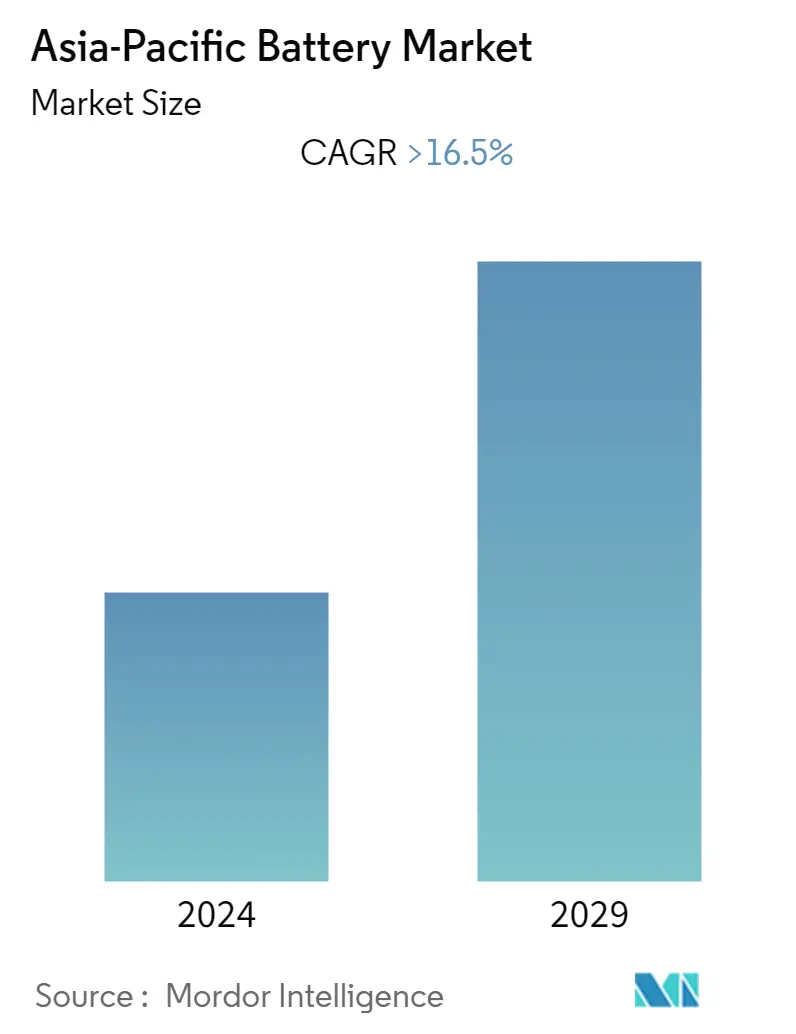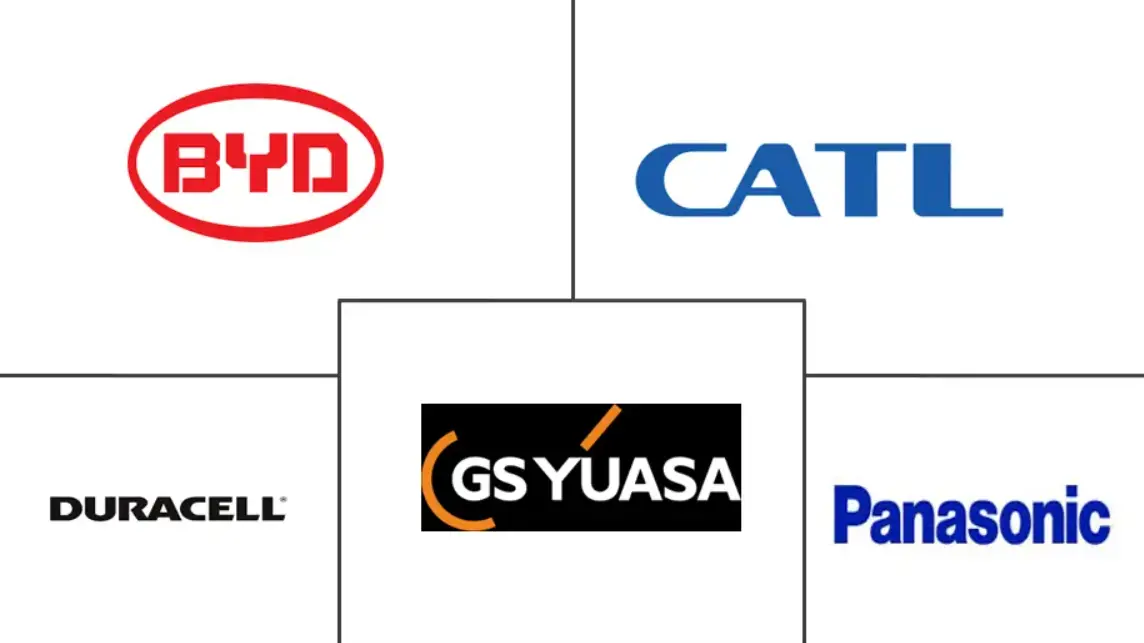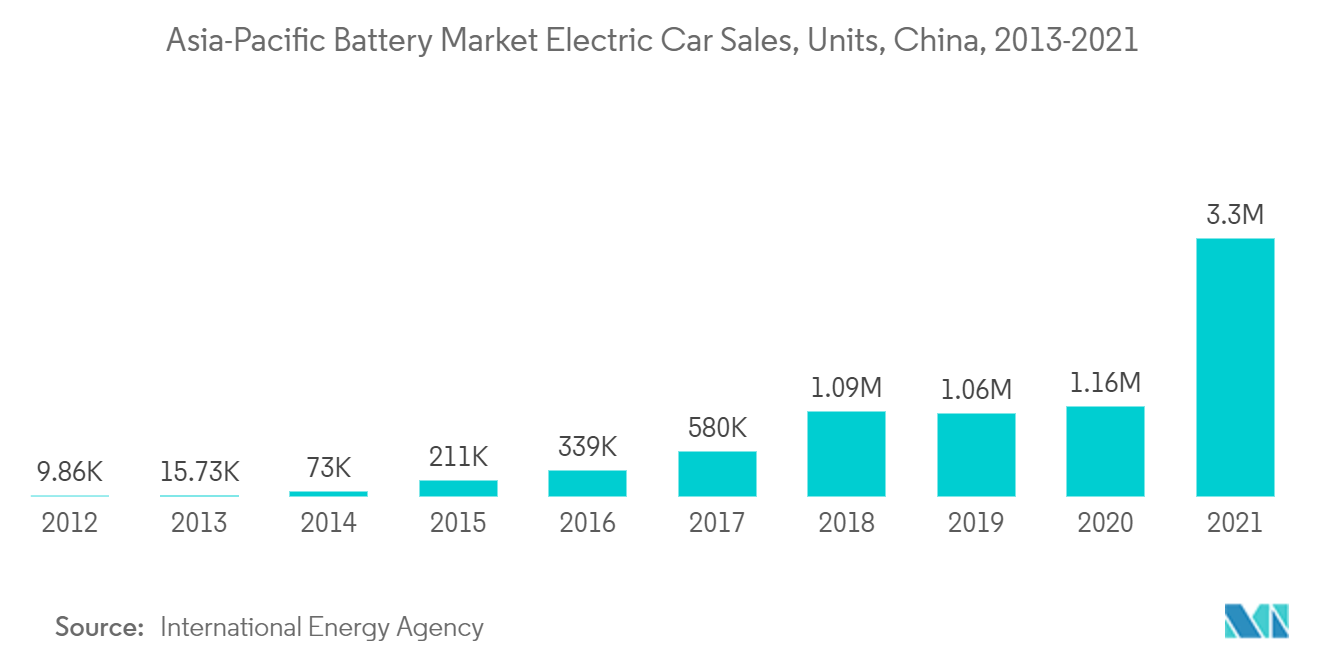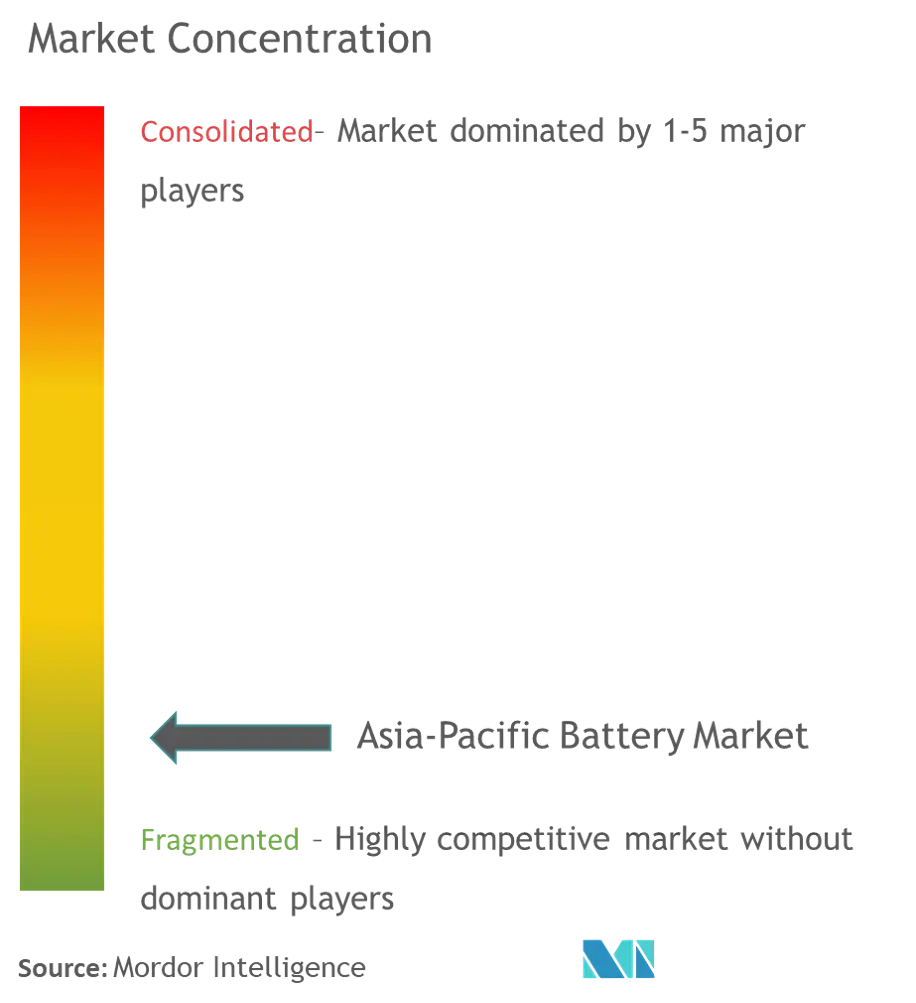Asia Pacific Battery Market Size

| Study Period | 2021 - 2029 |
| Base Year For Estimation | 2023 |
| Forecast Data Period | 2024 - 2029 |
| Historical Data Period | 2021 - 2022 |
| CAGR | 16.50 % |
| Market Concentration | Medium |
Major Players
*Disclaimer: Major Players sorted in no particular order |
Asia Pacific Battery Market Analysis
The Asia-Pacific Battery Market is expected to register a CAGR of more than 16.5% during the forecast period.
The market was negatively impacted by COVID-19 in 2020. Presently the market has now reached pre-pandemic levels.
- Over the medium term, factors including lithium-ion battery prices decline, rapid adoption of electric vehicles, growing renewable sector, and increased sale of consumer electronics are expected to drive the market.
- On the other hand, the demand-supply mismatch of raw materials is likely to restrain the market's growth in the coming years.
- Nevertheless, The automotive batteries segment is expected to be the fastest-growing segment in the battery market due to the increasing demand for new vehicles produced in the region. The segment is expected to be the leading end-user for lithium-ion batteries in the coming years. Plans to integrate renewable energy with the national grids in respective countries are expected to create a significant opportunity for lithium-ion battery manufacturers and suppliers in the future.
- India is likely to experience significant growth in the Asia-Pacific battery market based on policy-level support from the government encouraging the manufacturing sector.
Asia Pacific Battery Market Trends
This section covers the major market trends shaping the APAC Battery Market according to our research experts:
Automotive Battery Segment to Witness Significant Growth
- The automotive sector is anticipated to be one of the major end-user segments for lithium-ion batteries in the future. The penetration of electric vehicles will likely provide a massive impetus for the lithium-ion battery industry's growth.
- Different vehicle types are now available globally, featuring increasing degrees of hybridization and electrification, such as Hybrid Electric Vehicles (HEVs), plug-in hybrid electric vehicles, and Electric Vehicles (EVs).
- In developed and developing economies, the adoption of electric vehicles is increasing at a high rate. China is leading in global EV sales, and other developing economies like India are transforming their public transportation infrastructure for EVs.
- In the current market scenario, policy support plays a crucial role in driving the adoption of electric vehicles. Policy support enables market growth by making vehicles appealing to consumers, reducing risks for investors, and encouraging manufacturers to develop electric vehicles on a large scale.
- Falling battery prices and improving technology are expected to bring price-competitive electric vehicles to the market, creating demand for battery technologies.
- The global production of batteries for electric vehicles is concentrated in Asia-Pacific, with Chinese, Japanese, and South Korean companies dominating the sector and building factories in Europe to conserve their supremacy. As of 2021, China was the largest market for electric vehicles, as the country accounted for approximately 3300000 vehicles sold. The country is also making efforts to reduce air pollution levels, which is further expected to push the automotive battery segment.
- The Indian government has taken several initiatives to promote electric vehicles. In April 2019, Phase II of the Faster Adoption and Manufacturing of (Hybrid &) Electric Vehicles (FAME) India scheme was implemented for three years. The scheme's main objective is to promote faster adoption of electric and hybrid vehicles by providing an incentive for the purchase of electric vehicles and creating necessary charging infrastructure for electric vehicles, thereby boosting the automotive battery segment.
- The FAME India Scheme (which started in April 2019) was supposed to end by 2022. However, with the approval of competent authorities, the union government, in June 2021, decided that the FAME India Phase II Scheme will be extended for two years, i.e., up to March 2024. In Q1 of 2021, the union government increased incentives on electric two- and three-wheelers to help boost broad-based adoption. According to some industry experts, the government wanted to utilize the funds earmarked for the FAME scheme, with the sale of EVs remaining muted for the past two years.
- Thus, the automotive battery sector will likely witness significant growth with the increasing adoption of electric vehicles.

India to Witness Significant Growth
- Asia-Pacific has multiple growing economies with substantial natural and human resources. India is expected to become a major investment hotspot for battery companies in the coming years, based on the policy-level support from the governments encouraging the manufacturing sector.
- The Indian market is driven by increasing population, urbanization, declining cost of electronic items, the introduction of new smart technologies, and availability of the internet at a cheaper cost. Replacement of older smartphones with newer ones is also expected to drive the market's growth.
- The increasing penetration of telecommunication services provides an opportunity for the growth of the telecommunication market in India. Therefore, with the increase in subscribers, the requirement for telecommunication towers in the country is expected to increase, further fostering the demand for batteries required for backup purposes.
- India is among the top five emitters of CO2 in the world. To mitigate the problem of air pollution, the government has taken the initiative to implement policies favorable to increase the EV fleet count on the road.
- The government has clarified that entities planning to set up EV charging stations may not require licensing from the ministry. The Indian government also set an ambitious target of new vehicles sold after 2030 to be fully electric. Such initiatives are expected to drive the demand for batteries in the country.
- India has more than 50% of telecom towers located in sites that face outages for 8 hours a day or more. The telecom industry players must maintain an uptime of 99.5% or face penalties. As a result, the towers are heavily dependent on diesel generators. The telecom industry is moving toward renewable sources, particularly solar, in tandem with battery energy storage systems to reduce greenhouse emissions.
- To this effect, in February 2020, the Indian Department of Telecommunications issued directions to the telecom service providers to use renewable energy solutions and energy-efficient technologies, thereby boosting the Indian battery market.
- Hence, due to such factors, India is expected to witness significant growth in the Asia-Pacific battery market during the forecast period.

Asia Pacific Battery Industry Overview
The Asia-Pacific Battery Market could be more cohesive. Some major players include (not in particular order) Contemporary Amperex Technology Co. Limited, BYD Co. Ltd, Duracell Inc., GS Yuasa Corporation, and Panasonic Corporation.
Asia Pacific Battery Market Leaders
-
BYD Co. Ltd
-
Duracell Inc.
-
Panasonic Corporation
-
GS Yuasa Corporation
-
Contemporary Amperex Technology Co. Limited
*Disclaimer: Major Players sorted in no particular order

Asia Pacific Battery Market News
- January 2022: China Lithium Battery Technology signed two contracts with two cities in the southern Chinese province of Guangdong to build new production facilities with an annual capacity of 50 GWh. The factories will be located in Guangzhou and Jiangmen.
- January 2022: BYD and FAW are planning a production facility for electric car batteries with an annual capacity of 45 GWh in north-eastern China. A joint venture between BYD and FAW called FAW FinDreams New Energy Technology was established, with a registered capital of EUR 140 million. BYD holds 51% of the JV, and FAW Group owns the remaining.
Asia Pacific Battery Market Report - Table of Contents
1. INTRODUCTION
- 1.1 Scope of the Study
- 1.2 Market Definition
- 1.3 Study Assumptions
2. EXECUTIVE SUMMARY
3. RESEARCH METHODOLOGY
4. MARKET OVERVIEW
- 4.1 Introduction
- 4.2 Market Size and Demand Forecast in USD billion, till 2027
- 4.3 Battery/Raw Material Price Trends and Forecast, by Major Technology Type, till 2027
- 4.4 Import and Export Analysis, by Major Battery Technology and Major Country, in USD million, till 2020
- 4.5 Recent Trends and Developments
- 4.6 Government Policies and Regulations
-
4.7 Market Dynamics
- 4.7.1 Drivers
- 4.7.2 Restraints
- 4.8 Supply Chain Analysis
-
4.9 Porter's Five Forces Analysis
- 4.9.1 Bargaining Power of Suppliers
- 4.9.2 Bargaining Power of Consumers
- 4.9.3 Threat of New Entrants
- 4.9.4 Threat of Substitutes Products and Services
- 4.9.5 Intensity of Competitive Rivalry
5. MARKET SEGMENTATION
-
5.1 Type
- 5.1.1 Primary Battery
- 5.1.2 Secondary Battery
-
5.2 Technology
- 5.2.1 Lead-acid Battery
- 5.2.2 Lithium-ion Battery
- 5.2.3 Other Technologies
-
5.3 Application
- 5.3.1 Automotive Batteries (HEV, PHEV, and EV)
- 5.3.2 Industrial Batteries (Motive, Stationary (Telecom, UPS, and Energy Storage Systems (ESS))
- 5.3.3 Portable Batteries (Consumer Electronics)
- 5.3.4 Other Applications
-
5.4 Geography
- 5.4.1 India
- 5.4.2 China
- 5.4.3 Japan
- 5.4.4 South Korea
- 5.4.5 Rest of Asia-Pacific
6. COMPETITIVE LANDSCAPE
- 6.1 Mergers and Acquisitions, Joint Ventures, Collaborations, and Agreements
- 6.2 Strategies Adopted by Leading Players
-
6.3 Company Profiles
- 6.3.1 BYD Co. Ltd
- 6.3.2 Contemporary Amperex Technology Co. Limited
- 6.3.3 Duracell Inc.
- 6.3.4 EnerSys
- 6.3.5 GS Yuasa Corporation
- 6.3.6 Clarios International Inc.
- 6.3.7 LG Chem Ltd
- 6.3.8 Panasonic Corporation
- 6.3.9 Saft Groupe SA
- 6.3.10 Samsung SDI Co. Ltd
- 6.3.11 Tesla Inc.
- 6.3.12 TianJin Lishen Battery Joint-Stock Co. Ltd
- *List Not Exhaustive
7. MARKET OPPORTUNITIES AND FUTURE TRENDS
** Subject To AvailablityAsia Pacific Battery Industry Segmentation
A battery is an energy source that converts chemical energy into electrical energy consisting of one or two electrochemical cells by means of a redox reaction.
The Asia-Pacific Battery market is segmented by type, technology, application, and geography. The type includes primary battery and secondary battery. By technology type, the market is segmented into lead-acid batteries, lithium-ion batteries, and other technologies. The application consists of automotive batteries (HEV, PHEV, and EV), industrial batteries (motive, stationary (telecom, UPS, and Energy Storage Systems (ESS)), portable batteries (consumer electronics), and other applications. The report also covers the market size and forecasts for the Asia-Pacific Battery market across significant regions or countries. For each segment, the market sizing and forecasts have been done based on installed capacity (Megawatt).
| Type | Primary Battery |
| Secondary Battery | |
| Technology | Lead-acid Battery |
| Lithium-ion Battery | |
| Other Technologies | |
| Application | Automotive Batteries (HEV, PHEV, and EV) |
| Industrial Batteries (Motive, Stationary (Telecom, UPS, and Energy Storage Systems (ESS)) | |
| Portable Batteries (Consumer Electronics) | |
| Other Applications | |
| Geography | India |
| China | |
| Japan | |
| South Korea | |
| Rest of Asia-Pacific |
Asia Pacific Battery Market Research FAQs
What is the current Asia-Pacific Battery Market size?
The Asia-Pacific Battery Market is projected to register a CAGR of greater than 16.5% during the forecast period (2024-2029)
Who are the key players in Asia-Pacific Battery Market?
BYD Co. Ltd , Duracell Inc. , Panasonic Corporation , GS Yuasa Corporation and Contemporary Amperex Technology Co. Limited are the major companies operating in the Asia-Pacific Battery Market.
What years does this Asia-Pacific Battery Market cover?
The report covers the Asia-Pacific Battery Market historical market size for years: 2021, 2022 and 2023. The report also forecasts the Asia-Pacific Battery Market size for years: 2024, 2025, 2026, 2027, 2028 and 2029.
Asia Pacific Automotive Lead-Acid Battery Industry Report
Statistics for the 2024 Asia Pacific Automotive Lead-Acid Battery market share, size and revenue growth rate, created by Mordor Intelligence™ Industry Reports. Asia Pacific Automotive Lead-Acid Battery analysis includes a market forecast outlook 2029 and historical overview. Get a sample of this industry analysis as a free report PDF download.



